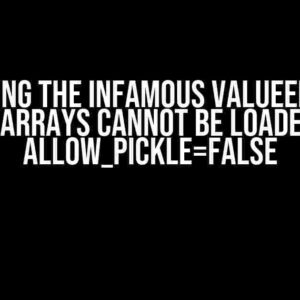Welcome to this comprehensive guide on how to convert a Pandas DataFrame index to HTML with merged cells. If you’re working with data in Python, chances are you’ve encountered the need to present your findings in a visually appealing way. In this article, we’ll take you through the process of creating an HTML table from a Pandas DataFrame, complete with merged cells to make your data shine!
What You’ll Need
To follow along with this tutorial, you’ll need to have Python installed on your computer, along with the Pandas library. If you don’t have Pandas installed, you can do so using pip:
pip install pandas
Creating a Sample DataFrame
Let’s start by creating a sample DataFrame to work with. We’ll use the following code to create a simple table with three columns: ‘Name’, ‘Age’, and ‘City’:
import pandas as pd
data = {'Name': ['John', 'Mary', 'John', 'David', 'Mary', 'John'],
'Age': [25, 31, 25, 42, 31, 25],
'City': ['NYC', 'LA', 'NYC', 'CHI', 'LA', 'NYC']}
df = pd.DataFrame(data)
The resulting DataFrame will look like this:
| Name | Age | City |
|---|---|---|
| John | 25 | NYC |
| Mary | 31 | LA |
| John | 25 | NYC |
| David | 42 | CHI |
| Mary | 31 | LA |
| John | 25 | NYC |
Setting the Index
In order to create a merged cell in our HTML table, we need to set the index of our DataFrame. We’ll set the ‘Name’ column as the index:
df.set_index('Name', inplace=True)
The resulting DataFrame will look like this:
| Name | Age | City |
|---|---|---|
| John | 25 | NYC |
| Mary | 31 | LA |
| John | 25 | NYC |
| David | 42 | CHI |
| Mary | 31 | LA |
| John | 25 | NYC |
Note that the ‘Name’ column is now the index, and the values in this column will be used to create merged cells in our HTML table.
Creating the HTML Table
To create the HTML table, we’ll use the `to_html` method provided by Pandas:
html = df.to_html()
The resulting HTML code will look like this:
<table border="1" class="dataframe">
<thead>
<tr style="text-align: right;">
<th></th>
<th>Age</th>
<th>City</th>
</tr>
</thead>
<tbody>
<tr>
<th>John</th>
<td>25</td>
<td>NYC</td>
</tr>
<tr>
<th>Mary</th>
<td>31</td>
<td>LA</td>
</tr>
<tr>
<th>John</th>
<td>25</td>
<td>NYC</td>
</tr>
<tr>
<th>David</th>
<td>42</td>
<td>CHI</td>
</tr>
<tr>
<th>Mary</th>
<td>31</td>
<td>LA</td>
</tr>
<tr>
<th>John</th>
<td>25</td>
<td>NYC</td>
</tr>
</tbody>
</table>
As you can see, the HTML table is created, but the index values are not merged. Let’s fix that!
Merging Cells in the HTML Table
To merge the cells in the HTML table, we’ll need to modify the HTML code generated by Pandas. We’ll use the following function to merge the cells:
def merge_cells(html):
soup = BeautifulSoup(html, 'html.parser')
table = soup.find('table')
rows = table.find_all('tr')
dict_cols = {}
for row in rows:
th = row.find('th')
if th:
dict_cols[th.text] = []
for row in rows:
th = row.find('th')
if th:
dict_cols[th.text].append(row)
for key, value in dict_cols.items():
span = len(value)
value[0].find('th').attrs['rowspan'] = span
for i in range(1, span):
value[i].find('th').decompose()
return str(soup)
This function uses the `BeautifulSoup` library to parse the HTML code and modify the table rows. It groups the rows by the index value, and then merges the cells by setting the `rowspan` attribute and removing the duplicate cells.
Now, let’s apply this function to our HTML code:
html_merged = merge_cells(html)
The resulting HTML code will look like this:
<table border="1" class="dataframe">
<thead>
<tr style="text-align: right;">
<th></th>
<th>Age</th>
<th>City</th>
</tr>
</thead>
<tbody>
<tr>
<th rowspan="3">John</th>
<td>25</td>
<td>NYC</td>
</tr>
<tr>
<td>25</td>
<td>NYC</td>
</tr>
<tr>
<td>25</td>
<td>NYC</td>
</tr>
<tr>
<th rowspan="2">Mary</th>
<td>31</td>
<td>LA</td>
</tr>
<tr>
<td>31</td>
<td>LAFrequently Asked Question
Get ready to dive into the world of pandas dataframes and learn how to merge cells in HTML tables!
How do I set the index of a pandas dataframe to HTML?
To set the index of a pandas dataframe to HTML, you can use the `to_html()` method and pass the `index` parameter as `True`. For example: `df.to_html(index=True)`. This will include the index column in the HTML table.
Can I customize the index column in the HTML table?
Yes, you can customize the index column by using the `index_names` parameter in the `to_html()` method. For example: `df.to_html(index=True, index_names=['My Index'])`. This will set the header of the index column to "My Index".
How do I merge cells in an HTML table generated from a pandas dataframe?
To merge cells in an HTML table generated from a pandas dataframe, you can use the `style` attribute in the `to_html()` method. For example: `df.style.set_properties(subset=['column1'], **{'background-color': 'red', 'border-top': '1px solid black', 'border-bottom': '1px solid black'}).render()`. This will merge the cells in the "column1" column and apply a red background color.
Can I merge cells across multiple rows or columns?
Yes, you can merge cells across multiple rows or columns using the `df.style.merge()` method. For example: `df.style.merge(cells=[(0, 0, 2, 2)], direction='right').render()`. This will merge the cells in the first two rows and columns.
What are some common use cases for merging cells in an HTML table?
Merging cells in an HTML table can be useful for creating header rows or columns, highlighting important data, or creating visually appealing tables. It's commonly used in report generation, data visualization, and business intelligence applications.



